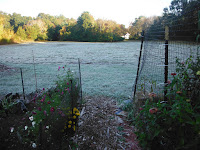Early Saturday morning, probably
about 4 a.m., a layer of cold air settled over the one-time farm field that is
the home of Medfield’s community garden.
Elsewhere in town, the cold air slipped down hillsides or was chased
away by roads that retained warmth. But,
in the valley (‘good bottom land’ in farming parlance) along the country road
on the south side of town, the air – probably no colder than 30 degrees – found
a pocket where it could stay, unmolested, for a few hours.
That’s all it took to send an
irrevocable eviction notice to our vegetable garden. Water freezes at 32 degrees and most vegetables
are little more than columns of water surrounded by thin membranes. By the time we got to the garden, the
zucchini leaves were limp and oily. Green tomatoes had dropped to the
ground. Our glorious crop of basil – our
best in years – was tinged with black.
Gone, all gone.
 |
| We had already harvested our winter squash |
We had already harvested our winter
squash. Had we not, it would have been
reduced to un-salvageable mush. A few
crops are light-frost hardy: the arugula, carrots, and chard will withstand
temperatures down into the mid-twenties for a few hours without suffering
damage.
But there is no doubt that the
summer gardening season is at an end.
Yeah, the beets will get a little bigger, and we’re promised
temperatures in the mid-70s early this week, but we’re down to 11 ½ hours of
sunlight, and the sun’s angle is such that ‘practical’ daylight is two hours
less.
The fat lady has sung. Start carving the pumpkins.
 |
| Frozen marigolds |
It was a glorious year for
gardening – though, like all years, one also filled with frustration. It took forever for our first crops to germinate
(it seemed never to stop raining in April and the temperature remained stubbornly in the 40's).
The bean beetles arrived on schedule in mid-July and halved our
crop of green beans. Someone in the
garden – either thoughtless or trying to save money – purchased tomatoes
infected with the fungus Phytophthora
from a Big Box store, and
late blight rampaged through everyone’s garden, including ours. (And no, late
blight isn’t inevitable. Three tomato
plants in our as-yet-frost-free home garden are still producing fruit.)
The successes far outnumbered
the failures. Betty and I have attempted
to grow fennel for years with nothing to show for it but inedible ferns. This year, every fennel plant thrived and we
feasted on it from early August on (there is some in the refrigerator). Our three squares of corn produced their
last, delicious ears just last week; and we even were able to strip, cut and
flash freeze the kernels of several ears during peak production days.
 |
| A coating of frost on our 'good bottom land' |
And, for the first time in a
decade, there will be winter squash and even sweet potatoes for the late fall
and winter. We encouraged butternut
squash vines to grow beyond their allotted space and colonize the void created
as rows of corn were pulled. The result
was 20 large squash that have been cleaned, dipped in a diluted bleach
solution, and sequestered in a dark corner of the basement. A gardening neighbor gave Betty two surplus
sweet potato ‘slips’ which we planted in an abandoned plot. This morning, with another gardener who will
share in the bounty, we harvested an impressive number of fat yams. They’ll be edible in about a month as they sit quietly in the basement converting starch to sugar.
 |
| The final cleanup |
We will harvest a few more crops
over the balance of the month. A row of
leeks came through the frost unscathed, as did our carrots, arugula and
chard. But there’s little to do but cart
away out the spent vines and, ultimately, take down the fence.
We’ll enjoy the fruits (well,
the vegetables) of our labor well into the future. Betty put up hot pepper
jelly and froze peas, corn and green beans.
We have enough of those crops to last well into the winter. It’s the squash, though, that is scary. At one squash per week (they’re that big), we’ll
be eating the last of our 2019 crop when we harvest our first spinach next
April. That’s what I call continuity.

